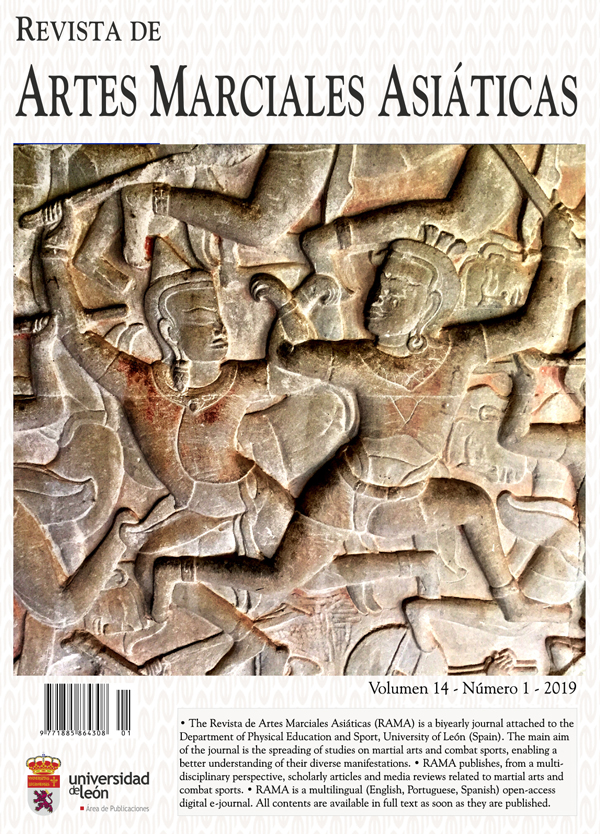Exploratory study on maturation and competition level in young karate practitioners
DOI:
https://doi.org/10.18002/rama.v14i1.5762Keywords:
Sports competition, maturation, Karate, martial arts, combat sports, kumiteAbstract
Paring children improve the chance for success and reduce injury in sport. Despite the maturity differences between children, chronological age remains the main criterion to equalize competition levels, but with limited efficiency. However, in Karate, weight is also considered. We went to investigate the association between chronological age and maturational indicators and find simple models to put on reflection new ways to assess the maturity. Data were collected in 54 young Karate practitioners (age: 12.67 ± 2.49 years, experience: 4.99 ± 2.44 years, height: 150.45 ± 15.25 cm, weight: 43.09 ± 14, 17 kg, 20 girls). Age correlated significantly with self-observation of sexual maturation (rho = 0.838; p < 0.01), and it was possible to find simple regression models that have a moderate explanation in maturation, using only simple measurable variables such as the height, weight and arm circumference. These results should lead the competent entities to reflect on the way of pairing of the athletes in the competitions, in a fair way in terms of maturation.
Downloads
Métricas alternativas
References
Anderson, G. S., & Ward, R. (2002). Classifying children for sports participation based upon anthropometric measurement. European Journal of Sport Science, 2(3), 1-13. doi: http://doi.org/10.1080/17461390200072301
Backous, D. D., Farrow, J. A., & Friedl, K. E. (1990). Assessment of Pubertal Maturity in Boys, Using Height and Grip Strength. Journal of Adolescent Health, 11(6), 497-500. doi: http://doi.org/10.1016/0197-0070(90)90109-F
Baxter-Jones, A. D. G., Eisenmann, J. C., & Sherar, L. B. (2005). Controlling for maturation in pediatric exercise science. Pediatric Exercise Science, 17(1), 18-30. doi: http://doi.org/10.1123/pes.17.1.18
Crampton, C. W. (1908). Physiological Age—A Fundamental Principle. American Physical Education Review, 13(4), 214-227. doi: http://doi.org/10.1080/23267224.1908.10650080
De la Fuente García, A. (2018). Height categories as a healthier alternative to weight categories in taekwondo competition. Revista de Artes Marciales Asiáticas, 13(1), 53-60. doi: http://doi.org/10.18002/rama.v13i1.5350
Dubnov-Raz, G., Mashiach-Arazi, Y., Nouriel, A., Raz, R., & Constantini, N. W. (2015). Can height categories replace weight categories in striking martial arts competitions? A pilot study. Journal of Human Kinetics, 47, 91-98. doi: http://doi.org/10.1515/hukin-2015-0065
Federação Nacional de Karate – Portugal. (2017). Regulamento Geral de Provas. Lisboa, Portugal: Federação Nacional de Karate – Portugal.
Fragoso, M. I. C. J., & Vieira, M. F. S. (2011). Cinantropometria: Curso Prático. Cruz Quebrada, Lisboa: Faculdade de Motricidade Humana.
Gabbett, T. J. (2015). Physical Qualities of Experts. In J. Baker & D. Farrow (Eds.), Routledge Handbook of Sport Expertise (pp. 121-129). London & New York: Routledge.
Khamis, H. J., & Roche, A. F. (1994). Predicting adult stature without using skeletal age: the Khamis-Roche method. Pediatrics, 94(4 Pt 1), 504-507.
Lohman, T. G., Roche, A. F., & Martorell, R. (1988). Anthropometric standardization reference manual. Champaign, IL: Human Kinetics Books.
Malina, R. M. (2000). Growth, maturation and performance. In Garret & Kirkendall (Eds.), Exercise and Sport Science (pp. 425-445). Philadelphia: Williams & Wilkins.
Malina, R. M., & Beunen, G. (1996). Monitoring of growth and maturation. In Bar-Or, Commission, & International Federation of Sports (Eds.), The Child and Adolescent Athlete (pp. 647-672). Oxford; Cambridge, Mass., USA; Champaign, Ill.: Blackwell Science.
Malina, R. M., Bouchard, C., & Bar-Or, O. (2004). Growth, Maturation, and Physical Activity (2nd ed.). Champaign, Ill.: Human Kinetics Books.
Pieter, W. (2012). Talent Detection in Taekwondo Practitioners. Revista de Artes Marciales Asiáticas, 5(2), 77-96. doi: http://doi.org/10.18002/rama.v5i2.112
Roberto, B., Elisabetta, M., & Giovanni, F. (2001). Variation in sexual dimorphism in relation to physical activity. American Journal of Human Biology, 13(3), 341-348. doi: http://doi.org/10.1002/ajhb.1057
Roche, A. F., Tyleshevski, F., & Rogers, E. (1983). Non-Invasive Measurements of Physical Maturity in Children. Research Quarterly for Exercise and Sport, 54(4), 364-371. doi: http://doi.org/10.1080/02701367.1983.10605321
Roche, A. F., Wainer, H., & Thissen, D. (1975). Predicting adult stature for individuals. Monographs in Paediatrics, 3, 1-114.
Stewart, A., Marfell-Jones, M., Olds, T., & Ridder, H. d. (2011). International Standards for Anthropometric Assessment. New Zealand: The International Society for the Advancement of Kinanthropometry.
Tanner, J. M. (1962). Growth at adolescence (2nd ed.). Oxford: Blackwell Scientific Publications.
Towlson, C., Cobley, S., Parkin, G., & Lovell, R. (2018). When does the influence of maturation on anthropometric and physical fitness characteristics increase and subside? Scandinavian Journal of Medicine & Science in Sports, 28(8), 1946-1955. doi: http://doi.org/10.1111/sms.13198
Winter, E. M., & Cobb, M. (2008). Ethics in Paediatric Research: Principles and Processes. In N. Armstrong & W. v. Mechelen (Eds.), Paediatric Exercise Science and Medicine (pp. 3-12). Oxford: Oxford University Press.
Downloads
Published
How to Cite
Issue
Section
License
Copyright (c) 2019 Marco Branco, António VencesBrito, Ana Paula Seabra, Cristiana Mercê, Mário A. Rodrigues-Ferreira, Vitor Milheiro, David Catela

This work is licensed under a Creative Commons Attribution-NonCommercial-ShareAlike 4.0 International License.
The authors who publish in this journal must agree to the following terms:
- The authors grant on a nonexclusive basis the exploitation rights (reproduction, distribution, public communication and transformation) of the work accepted for publication to the University of León. The authors can establish, on their own, additional agreements for the non-exclusive distribution of the version of the work published in the journal (for example, placing it in an institutional repository or publishing it in a book), always acknowledging the initial publication in this journal.
- This work is licensed under the Creative Commons Attribution-NonCommercial-ShareAlike 4.0 International License. Click to see basic information and the legal text of the license.
- The authors are allowed and encouraged to disseminate electronically pre-print or post-print versions of their work before publication, as this can give rise to productive exchanges, as well as earlier and increased citing of the works published.











